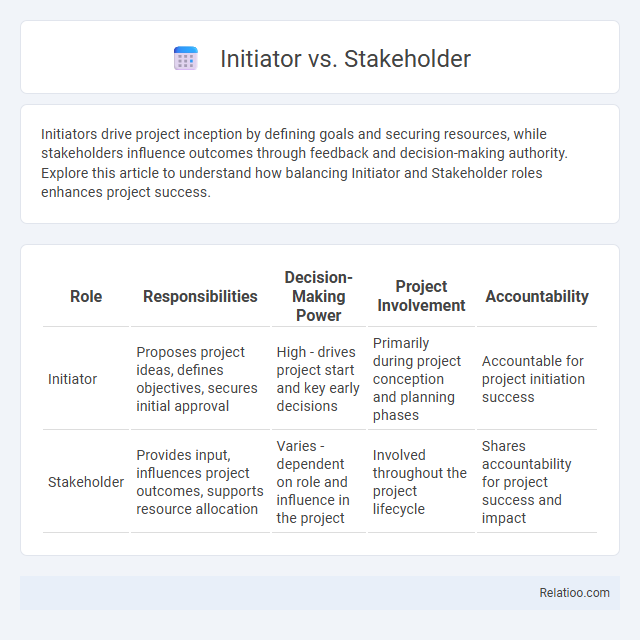Initiators drive project inception by defining goals and securing resources, while stakeholders influence outcomes through feedback and decision-making authority. Explore this article to understand how balancing Initiator and Stakeholder roles enhances project success.
Table of Comparison
| Role | Responsibilities | Decision-Making Power | Project Involvement | Accountability |
|---|---|---|---|---|
| Initiator | Proposes project ideas, defines objectives, secures initial approval | High - drives project start and key early decisions | Primarily during project conception and planning phases | Accountable for project initiation success |
| Stakeholder | Provides input, influences project outcomes, supports resource allocation | Varies - dependent on role and influence in the project | Involved throughout the project lifecycle | Shares accountability for project success and impact |
Understanding the Roles: Initiator vs Stakeholder
Understanding the roles between initiator and stakeholder is crucial for effective project management. The initiator is responsible for defining the project's objectives and securing necessary approvals, while stakeholders include anyone affected by or with an interest in the project's outcome. You should clearly identify these roles to ensure proper communication, accountability, and successful project execution.
Key Definitions: Who is an Initiator?
An Initiator is the person or entity responsible for starting a project or process by defining its objectives and securing initial approval. A Stakeholder, in contrast, includes anyone affected by or involved in the project, such as sponsors, team members, or customers. Your understanding of an Initiator's role is crucial for clarifying project ownership and ensuring clear accountability from the outset.
Stakeholder: Meaning and Significance
Stakeholders are individuals or groups directly or indirectly affected by a project's outcome, playing a crucial role in its success by providing resources, support, and feedback. Unlike initiators who start the project and owners who oversee its execution, stakeholders' interests and influence vary widely and require careful management to align with project goals. Understanding your stakeholder's needs and expectations enables effective communication and fosters collaboration essential for achieving sustainable results.
Primary Responsibilities of an Initiator
The primary responsibilities of an initiator include defining project objectives, securing initial approvals, and allocating necessary resources to ensure project momentum. Unlike stakeholders who influence and are affected by project outcomes, or sponsors who provide financial backing and strategic alignment, the initiator drives project kickoff and scope clarification. Your role as an initiator is critical in establishing clear goals and aligning team efforts from the outset.
Core Functions of Stakeholders in Projects
Stakeholders play a pivotal role in projects by influencing decision-making, providing resources, and ensuring alignment with organizational goals. Their core functions include identifying project requirements, endorsing project scope, and actively engaging in risk management to mitigate potential issues. Effective stakeholder involvement ensures project success through continuous communication and feedback loops.
Initiator’s Influence on Project Lifecycle
The initiator holds pivotal influence over the project lifecycle by defining initial objectives, securing resources, and setting the strategic direction that guides stakeholder involvement and decision-making processes. Their early engagement ensures alignment of project goals with organizational priorities, directly impacting project scope, timeline, and deliverables. Stakeholders contribute ongoing input and support, but the initiator's vision and authority fundamentally shape project initiation, planning, execution, and closure phases.
Stakeholder Engagement and Communication
Stakeholder engagement involves identifying and actively involving all relevant stakeholders, including initiators, project managers, and end users, to ensure their needs and concerns are addressed throughout the project lifecycle. Effective communication strategies tailored to stakeholders' interests foster collaboration, build trust, and promote transparent decision-making. Prioritizing continuous feedback and information sharing enhances project success by aligning objectives and managing expectations among all parties.
Initiator vs Stakeholder: Main Differences
The main differences between an Initiator and a Stakeholder lie in their roles and responsibilities within a project. An Initiator is the person or entity who kickstarts the project by defining its purpose and securing initial approval, while a Stakeholder encompasses anyone affected by or interested in the project's outcome. Your understanding of these distinctions helps clarify accountability and communication channels throughout the project lifecycle.
Collaboration Between Initiators and Stakeholders
Effective collaboration between initiators and stakeholders drives project success by aligning goals, resources, and expectations. Initiators define project objectives and scope, while stakeholders provide critical input, feedback, and support essential for informed decision-making. Your ability to foster transparent communication and mutual understanding enhances teamwork, reduces risks, and accelerates project delivery.
Best Practices for Managing Both Roles
Effective management of Initiators and Stakeholders involves clear communication and role definition to ensure alignment on project goals and responsibilities. Your best practice includes establishing transparent channels for feedback and decision-making, enabling both roles to contribute insights while avoiding overlaps and conflicts. Regular status updates and collaborative planning sessions foster trust and keep both Initiators and Stakeholders engaged in project success.

Infographic: Initiator vs Stakeholder
 relatioo.com
relatioo.com